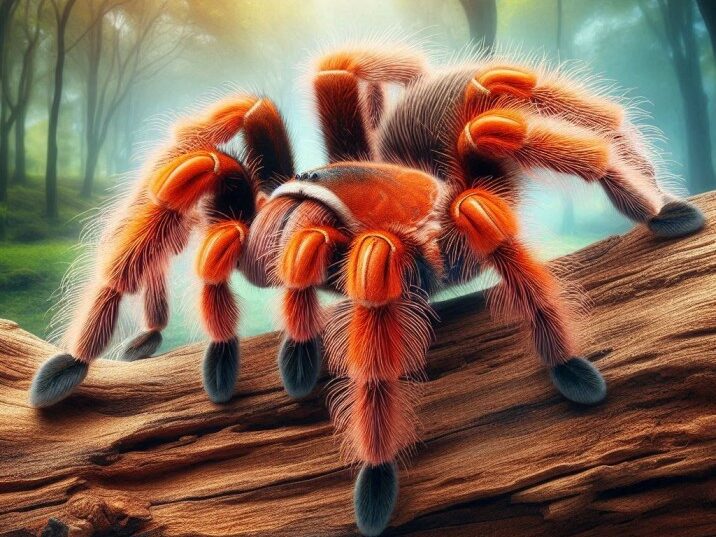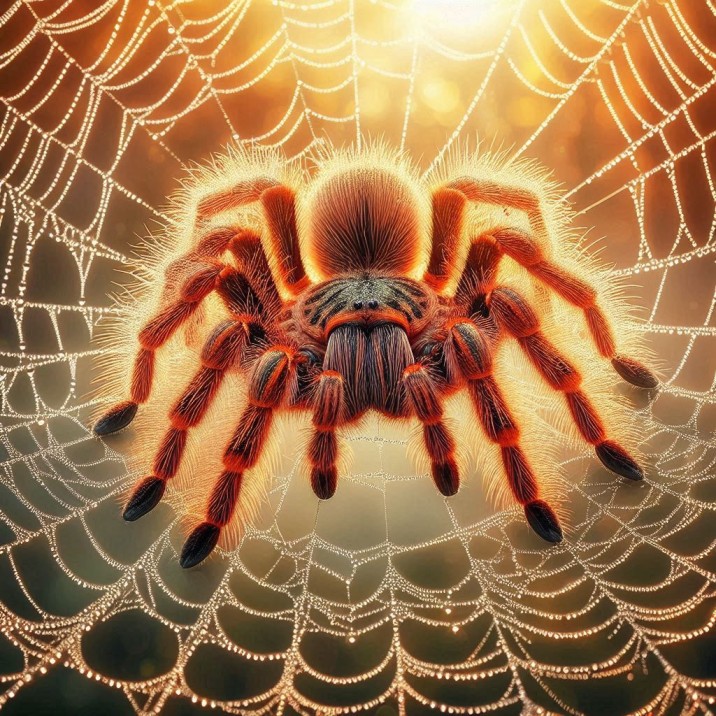Table of Contents
Table of Contents
- Introduction
- Table of Information
- Appearance and Coloration
- A Burst of Orange
- Distinctive Features
- Habitat and Distribution
- Native to Africa
- Adapted to Dry Conditions
- Behavior and Temperament
- An Aggressive Reputation
- Webbing Habits
- Care and Maintenance
- Housing Requirements
- Substrate and Environment
- Feeding and Diet
- Lifespan and Molting
- Long-Lived Females
- Molting Process
- Handling and Safety
- Observing from a Distance
- Safety Precautions
- Fascination and Fear
- A Popular Pet
- Respect for Nature
- FAQs
- Conclusion
Introduction
The orange baboon tarantula is a captivating and fascinating spider that stands out due to its striking coloration and intriguing behavior. Known scientifically as Pterinochilus murinus, this tarantula, native to Africa, has captivated the attention of spider enthusiasts and pet owners alike. Often called the OBT or “Orange Bitey Thing,” this tarantula is renowned for its vibrant orange color and assertive personality. In this article, we will delve into the world of the orange baboon tarantula, exploring its habitat, behavior, care requirements, and more.

Table of Information
| Feature | Details |
|---|---|
| Scientific Name | Pterinochilus murinus |
| Common Names | Orange Baboon Tarantula, OBT |
| Color | Bright Orange |
| Size | 4-6 inches (10-15 cm) |
| Native Region | Africa (East and South) |
| Temperament | Aggressive, Defensive |
| Diet | Insects (crickets, mealworms) |
| Lifespan | 5-12 years (females live longer) |
| Habitat | Dry, savanna, and scrubland areas |
Appearance and Coloration
A Burst of Orange
The orange baboon tarantula is renowned for its vibrant orange hue. This color makes it one of the most visually striking tarantulas. Its entire body, including the legs, is covered in this bright, attention-grabbing color, making it a favorite among spider enthusiasts. The orange coloration serves as a warning to potential predators, indicating that this spider is not one to be messed with.
Distinctive Features
In addition to its color, the orange baboon tarantula has a robust and hairy body. It also sports a characteristic starburst pattern on its carapace (the hard upper shell). This pattern adds to its unique and menacing appearance, making it easy to identify among other tarantulas.
Habitat and Distribution
Native to Africa
The orange baboon tarantula is native to the savannas and dry scrublands of East and Southern Africa, including countries like Kenya, Tanzania, and Zimbabwe. These regions provide the perfect environment for the tarantula, with their dry and warm climates.
Adapted to Dry Conditions
In its natural habitat, the orange baboon tarantula thrives in dry, arid environments. It often makes its home in burrows or under rocks and logs. The tarantula is well-adapted to these conditions, capable of surviving in areas with limited water supply.
Behavior and Temperament
An Aggressive Reputation
The orange baboon tarantula is known for its aggressive and defensive nature. Unlike some other tarantulas that might retreat when threatened, the OBT is more likely to stand its ground and show off its impressive defensive displays. This behavior has earned it a reputation among spider keepers as a “look but don’t touch” pet.
Webbing Habits
One of the fascinating aspects of the orange baboon tarantula is its webbing. It is an industrious web-builder, often creating extensive and complex webs in its enclosure. These webs are not only used for trapping prey but also for providing the tarantula with a sense of security and a place to retreat.
Care and Maintenance
Housing Requirements
Keeping an orange baboon tarantula as a pet requires careful consideration of its housing needs. A secure and escape-proof enclosure is essential due to its aggressive nature. A 10-gallon tank is typically sufficient, and it should be equipped with a secure lid to prevent escapes.
Substrate and Environment
The enclosure should have a deep layer of substrate, such as coconut fiber or peat moss, to allow for burrowing. Providing hiding spots, such as cork bark or clay pots, helps the tarantula feel secure. The humidity should be kept relatively low, around 50-60%, with a temperature range of 75-85°F (24-29°C).
Feeding and Diet
The orange baboon tarantula has a typical tarantula diet consisting mainly of insects. Crickets, mealworms, and roaches are all suitable food items. It is important to feed appropriately sized prey and to ensure that uneaten food is removed from the enclosure to prevent mold and mites.
Lifespan and Molting
Long-Lived Females
Female orange baboon tarantulas can live for up to 12 years or more in captivity, making them a long-term commitment for pet owners. Males typically have a shorter lifespan, living for around 3-5 years.
Molting Process
Tarantulas grow by molting, a process in which they shed their old exoskeleton and form a new one. This can be a stressful time for the spider, and it is crucial to provide a safe and undisturbed environment during molting. Signs of an impending molt include reduced activity and a darkening of the tarantula’s body.
Handling and Safety
Observing from a Distance
Due to their aggressive nature, it is generally recommended to avoid handling orange baboon tarantulas. They are more suited to being observed rather than interacted with. Handling can cause stress to the tarantula and poses a risk of bites to the handler.
Safety Precautions
When maintaining the enclosure, it is important to exercise caution. Using long tweezers and wearing gloves can help minimize the risk of accidental bites. It is also advisable to work in a well-lit area and to have a plan in place in case the tarantula tries to escape.
Fascination and Fear
A Popular Pet
Despite their aggressive tendencies, orange baboon tarantulas are popular in the pet trade due to their striking appearance and fascinating behavior. They provide a unique challenge for experienced spider keepers and are admired for their beauty and boldness.
Respect for Nature
It is essential to approach the orange baboon tarantula with respect and understanding. They are wild animals with specific needs and behaviors, and appreciating them from a distance allows us to marvel at their role in the ecosystem without putting ourselves or the tarantula at risk.
Conclusion
The orange baboon tarantula is a fascinating and visually stunning spider that captivates the imagination of those who encounter it. With its vibrant orange color and assertive personality, it stands out among other tarantulas. While it may not be the best choice for handling, it offers a unique and rewarding experience for those who appreciate its beauty and behavior from a respectful distance. Whether you are a seasoned spider enthusiast or a curious newcomer, the orange baboon tarantula provides a window into the diverse and captivating world of arachnids.
FAQs
1. Are orange baboon tarantulas dangerous?
Answer: While their bite is painful and they have a defensive nature, they are not considered dangerous to humans if handled responsibly and with respect.
2. How big do orange baboon tarantulas get?
Answer: They typically reach a size of 4-6 inches (10-15 cm) in leg span when fully grown.
3. What do orange baboon tarantulas eat?
Answer: Their diet consists mainly of insects such as crickets, mealworms, and roaches.
4. Can orange baboon tarantulas be handled?
Answer: It is generally not recommended to handle them due to their aggressive nature and the risk of bites.
5. How long do orange baboon tarantulas live?
Answer: Females can live for up to 12 years or more, while males typically live for around 3-5 years.

